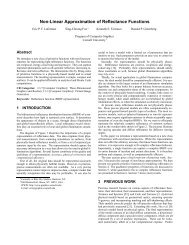pigmented colorants: dependence on media and time - Cornell ...
pigmented colorants: dependence on media and time - Cornell ...
pigmented colorants: dependence on media and time - Cornell ...
Create successful ePaper yourself
Turn your PDF publications into a flip-book with our unique Google optimized e-Paper software.
a change in our percepti<strong>on</strong> of the color–our eye integrates the surface reflectance<br />
with the incident light against our color sensitivity matching functi<strong>on</strong>s.<br />
In order to manage the dataset, an interactive viewer was made to browse<br />
between the 126 pigment-<strong>time</strong> combinati<strong>on</strong>s. This allowed for easier viewing of<br />
the data as <strong>on</strong>e can quickly see the relati<strong>on</strong>ships between different samples. The<br />
<strong>on</strong>line applicati<strong>on</strong> was written in JavaScript, allowing for instant feedback from a<br />
user-specified pigment <strong>and</strong> <strong>time</strong> combinati<strong>on</strong>. After selecting the input parameters,<br />
the system presents a spectral reflectance plot of the eight different binding <strong>media</strong><br />
for the chosen input data. The setup for the viewer is seen in Figure 6.1 for<br />
Lapis lazuli samples that have been dry for <strong>on</strong>e day. The input data is chosen via<br />
drop-down menus in the top-left of the screen. To tint the chosen pigment, the<br />
checkbox is selected. Updating the graphics with new selecti<strong>on</strong>s is d<strong>on</strong>e with the<br />
display butt<strong>on</strong>.<br />
A photograph of the pigment is shown for reference in the top-right (for tints,<br />
titanium dioxide white is also shown). Also presented is the corresp<strong>on</strong>ding digital<br />
photograph for each paint sample, as spectral graphs are not a very intuitive way<br />
to analyze subtle color shifts. Yet, it is important to note that the spectral data<br />
is what is critical. Displays have significant limitati<strong>on</strong>s: m<strong>on</strong>itors approximate<br />
colors using <strong>on</strong>ly three phosphors (red, green <strong>and</strong> blue), while printers <strong>on</strong>ly use<br />
fours inks (cyan, magenta, yellow <strong>and</strong> black) to create images. As a result, many<br />
real-world colors cannot be captured by these devices. Therefore, any photographic<br />
representati<strong>on</strong> will be an inadequate representati<strong>on</strong> of the actual colors.<br />
The importance of the spectral plots is that they show the behavior of light at<br />
all wavelengths in the visible spectrum. The spectral data combined with an illu-<br />
167<br />
minant <strong>and</strong> the eye’s resp<strong>on</strong>se curves can be predictive with no loss of informati<strong>on</strong>.



